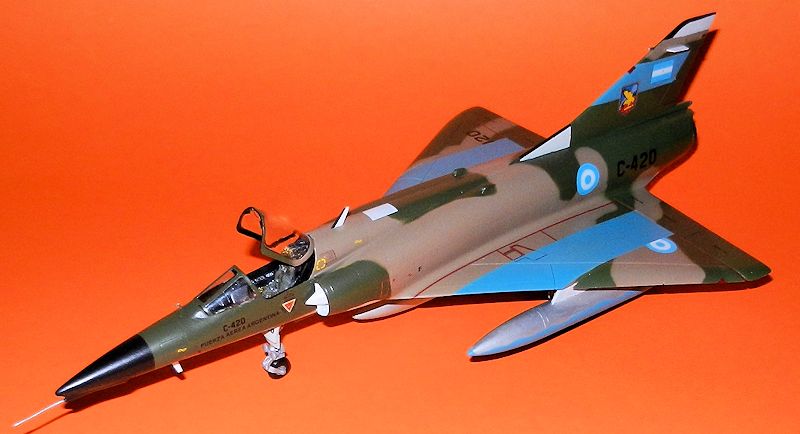
Italeri 1/48 IAI Dagger
| KIT #: | 2634 |
| PRICE: | CAD$30.00 |
| DECALS: | Four options |
| REVIEWER: | Pablo Calcaterra |
| NOTES: |

| HISTORY |
Israel developed their Mirage V version once France decided to cancel the
delivery of these already purchased planes to this country. There are at least 2
versions about how Israel got hold of the plans and parts to manufacture their
Neshers. Whichever the truth the “Vulture” (Nesher) were a simplified version of
the Mirage V and 61 (51 single seat, 10 trainers) were built without license.
Yes, simplified (compared to the MIIICJ version), but lethal as well. Neshers
accounted for more than 100 air to air claims during the 1973 war!
Being pretty close to go to war against Chile in 1978 the Argentine Air Force
purchased 26 (24 single seat and 2 trainers) of the surviving IAI Neshers. Their
serial numbers in Argentina were C-401 to 426 (“C” meaning Cazabombardero =
Fighter bomber). These were bought thru a secret contract and taken to Argentina
by ship. A group of pilots and ground crew were sent to Israel undercover to be
trained in the use of these “simplified” Mirages. Among them we can name Mj
Sapolsky, Capt Donadille, Pergolini, Kahijara, Martinez and Puga and 1st
Lt Arnau, Mir Gonzalez, Almono, DiMeglio, Janett and Musso. They became the
experts in this new Mirage version within the Air Force, as they were taught to
fly their planes to their limit, compared to the French school (Mirage IIIEA)
that were more “conservative” in terms of handling of the airplanes.
C-420 was sn-38 in Israeli inventory having been accepted in July 1973. This
particular plane arrived in 1979 and was one of the planes of the first batch
purchased.
A second batch of planes with the remainder planes was offered and accepted by
Argentina in 1979 and they were coded C-427 to C-439. These included 2 more
trainers (438 and 439).
Neshers were baptized Daggers in Argentina and were based in BAM Tandil (Buenos
Aires Province)
After April 2nd 1982, as part of the escalations in the conflict
between Argentina and the United Kingdom three Escuadrones (Squadrons) were
activated:
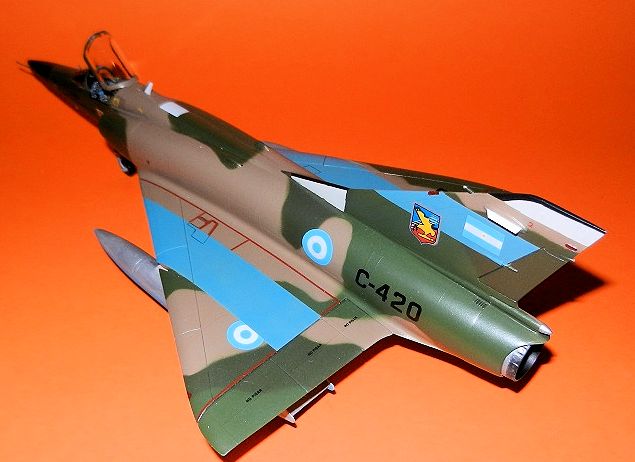 A)
Escuadron I was left in Tandil and was used to train pilots (one single seat and
three trainers in service) and also to receive the 10 Mirage 5P that Peru gave
to Argentina (first flight on June 14th)
A)
Escuadron I was left in Tandil and was used to train pilots (one single seat and
three trainers in service) and also to receive the 10 Mirage 5P that Peru gave
to Argentina (first flight on June 14th)
B)
Escuadron II was called La Marinete and was based in BAM San Julian
C)
Escuadron III was called Avutardas Salvajes and their base was now in BAM Rio
Grande (Tierra del Fuego)
C-420 was part of La Marinete and flown by Capt. Di Meglio arrived in BAM
Comodoro Rivadavia on April 6th along with other 11 planes. Part were
destined to Rio Grande as Escuadron IIII and the rest were to stay in Comodoro
Rivadavia as Escuadron II. Upon arriving C-420 was found to be out of service.
As the Air Force pilots had no training to attack targets on the sea (as this
was the Navy’s responsibility) the month was spent learning the trade.
On April 17th C-420 gyroscopic system was found U/S so the plane was
sent back to Tandil for repairs.
Because of the relatively short legs of the planes it was decided to move the
Daggers from Comodoro Rivadavia to San Julian where the A4-Cs were based.
On April 28th yellow ID bands were applied to the planes on the wings
and tail.
With the British Task force getting really close to the area and an alarm of an
approaching air strike to San Julian, all planes were scrambled at 10 pm on the
29th. They landed in Tandil and returned on May 1st in bad
weather. By then the first strikes of Vulcans and Sea Harriers had taken place.
As a consequence, the Fuerza Aerea Argentina Sur (or FAS) put in motion the
wheels to strike back.
After the actions on May 1st reinforcement were sent to the
squadrons. C-420 flew to San Julian with Lt. Castillo in the cockpit.
On May 9th two British ships were detected close to the North coast
of the Islands. Weather was awful, though, and most of the missions were aborted
as visibility was nil. OF 1176 (JAGUAR) was one of those: Vcom. Villar (C-404),
1st. Lt. Roman (C-420), Capt. Dimeglio (C-434) and Lt. Aguirre Faget
(C-415). Along with the PUMA (4 more Daggers) they took off at 13:45 and flew
close to the West coast of the islands. Finding 8/8 and rain and without being
able to contact the radar based in Puerto Argentino they decided to return to
their base landing there at 15:10. (It must be highlighted that Dimeglio, Roman
and Aguirre Faget were the same 3 Dagger pilots that attacked the 3 British
ships that were shelling Puerto Argentino/Stanley on May 1st forcing
them to flee. They constituted a trio that always flew together).Two A4-Cs
decided to go ahead regardless and were lost when they crashed against Jason Is
(Islas Salvajes)
On May 21st Operation Sutton started: the British Task force finally
landed in San Carlos. This was the moment that the Argentine Air Force was
looking for, as since May 1st and with the exception of May 12th
the Task Force had kept well to the East of the islands and out of range of the
land based aviation.
C-420 did not take part in the actions on this day. On May 23rd OF
1216 (CORAL) was scheduled to attack the ships in San Carlos. They were: Capt.
Dimeglio (C-421), 1st Lt. Roman (C-434) and Lt. Aguirre Faget
(C-420). After taking off at 12:54 and when close to San Carlos waters they were
informed about the presence of CAPs in the area so they turned around, aborted
the attack and returned to their base.)
 Just 5
minutes after midnight on the 24th the ground crews received the
order to over paint the yellow ID bands with green paint. Driving back from the
hotel where they were based, 1st Lt Posadas and his ground crew team
rang the bell of every single paint shops in town in order to find green paint
and some brushes. The only thing they were able to get was some blue greenish
paint. At 1 am in the morning they started their work but the frosted surfaces
of the planes prevented the paint from adhering to the planes. To remove the ice
and water they had to work hard during the early hours of the day with cloths
and newspapers until they were able to achieve their objective. The yellow and
blue greenish combination gave the ID bands that kind of “turquoise” color that
can be seen in many pictures.
Just 5
minutes after midnight on the 24th the ground crews received the
order to over paint the yellow ID bands with green paint. Driving back from the
hotel where they were based, 1st Lt Posadas and his ground crew team
rang the bell of every single paint shops in town in order to find green paint
and some brushes. The only thing they were able to get was some blue greenish
paint. At 1 am in the morning they started their work but the frosted surfaces
of the planes prevented the paint from adhering to the planes. To remove the ice
and water they had to work hard during the early hours of the day with cloths
and newspapers until they were able to achieve their objective. The yellow and
blue greenish combination gave the ID bands that kind of “turquoise” color that
can be seen in many pictures.
On this day (24th) more missions were scheduled to attack the landing
area. OF 1227 (PLATA) was made up of Capt Dellepiane in C-434, 1st
Lt. Musso (a former Dagger pilot who had volunteered in early April to return to
the Air Force as he was by then a captain in Aerolineas Argentinas) in C-420 and
1st Lt. Callejo in C-421. Another section (ORO) was supposed to take
off first but a mechanical failure meant that they ceded their place to the
PLATA. Like it happened on the 21st, the second section (the one that
was supposed to take off first) was intercepted and all were shot down (look for
my C-430 in 1/48 elsewhere for details). PLATA section reached the target area
first flying north of Pebble Island (Borbon) and then reached the landing area.
Musso in C-420 said that he had to attack the small harbour in San Carlos and
they were fired at with guns, missiles and everything that the British had at
hand. Dellepiane, flying by Musso, turned his plane on one side showing Musso
his undersides. At that moment a missile fired to them passed between both
Daggers! Musso dropped his bombs on a ground target and he could see, flying so
low, the British soldiers aiming at them with portable anti aircraft missiles.
He made several maneuvers to avoid the enemy fire and finally arrived to the
sea. He thought: “OK, I am saved” but he realized he was flying to the EAST
(towards Africa, as he remembers). Always skimming the waves, he turned to the
continent and close to the Northern entrance of San Carlos waters he found 2
British ships: HMS Coventry and Broadsword. He started to think: “they will hit
me, they will hit me” but he was not fired at. Some instants later and using the
same escape route Callejo faced the British ships as well. He flew towards the
islands to escape the “42-21 combo” and one of the ships fired a missile at him
though the captain of HMS Coventry says that the planes were out of range and in
his book does not mention firing a missile. Callejo immediately dropped his 3
empty 1,300 lt. tanks, turned sharply to the right and succeeded in evading the
missile. Those seconds to get to the coast of the islands seemed age. When the
PLATAs landed they found that C-420 had some impacts of light guns in the right
drop tank, C-421 did not release one of the bombs and C-434 windshield was
cracked by an impact of enemy fire. As C-421 touched down and was running
towards the tarmac non-commissioned officer Quiroga (armament expert) realized
that arming vane of the still hanging bomb was turning free. Immediately Callejo
was told to stop the plane on the runway, he deplaned and then the plane was
carefully pushed to a “safe area”. Everybody took cover except for Quiroga,
Corporal Diaz and 1st Lt Posadas who planned how to disarm the bomb.
Posadas thought that it all looked like in the movies…but it was for real!
Quiroga was disassembling the bomb, passing the parts to Diaz who would pass
them to Posadas who left them on the floor. Once the bomb was
 opened and
he could see the mechanism Quiroga unscrewed the system and after several
minutes of hard work and tension he was able to make the bomb safe. With a
scream of joy they left the plane and celebrated: not only they have saved their
lives but also a very needed and precious plane. It was only then that they
realized that the plane was close to one of the bombs depots and that some of
the ground crew had taken cover behind it!
opened and
he could see the mechanism Quiroga unscrewed the system and after several
minutes of hard work and tension he was able to make the bomb safe. With a
scream of joy they left the plane and celebrated: not only they have saved their
lives but also a very needed and precious plane. It was only then that they
realized that the plane was close to one of the bombs depots and that some of
the ground crew had taken cover behind it!
May 26th: OF 1241 (POKER) was to bomb the ground positions at San
Carlos. Capt Dimeglio in C-420 and Lt. Aguirre Faget in C-416 had their planes
bombed up with 2 x 250 kg bombs in stations 3 and 5, 2 drop tanks (1,300 lt) on
stations 2 and 6 and a Nafgan ventral tank in station 4 with 2 x 250 kg boms.
All these bombs were parachuted dragged and set to explode 1 mt above the
ground. Taking off at 13:30 they were guided by the radar in Puerto Argentino/Port
Stanley and when above San Carlos harbour they were told to start their bomb
run. They dive bombed at 60 degrees, released the bombs (the ground was hidden
by clouds) and then returned without problem to San Julian.
On May 29th the Air Force decided to give close support to their
beleaguered troops in Goose Green/Darwin. The by now well-known trio Dimeglio/Roman/Aguirre
Faget constituted the PATRIA section (OF1264). The leader was again Dimeglio in
C-420, with Roman in C-421 and Aguirre Faget in C-416. C-416 had a failure in
the oxygen system so could not take part. The other two planes took off but once
in the air they were told that a section from Rio Grande would attack instead.
Before turning back Dimeglio asked for the authentication code in case the order
to return was actually a British deception. Once he confirmed that the return
order was true, they emptied the external drop tanks, returned and landed. That
very same day, OF 1269 (PUMA) ordered an attack to a concentration of
helicopters and troops 40 km West of Puerto Argentino (Stanley). They were to
drop the bombs and then attack again with priority to helicopters and then
troops. Capt Dellepiane flew C-421 this time with his wingmen being 1st
Lt Callejo in C-420 and Capt. Dimeglio in C-416. When getting close San Carlos
waters, they were intercepted by a British CAP and had to return to base. They
had dropped their external loads but C-421 had a tank partially hanging from the
left station. The emergency ground crew was alerted. When the plane touched
down, the tank fell free and caught fire but there were no consequences to the
plane or pilot. An impact of a bullet or shrapnel was found upon inspection of
the station.
 On June 4th
another ground attack mission was ordered in which C-420 took part. OF 1277
(PINA) called for 4 Daggers led by Squadron Leader Vice commodore Villar in
C-432 to dive bomb ground troops in Mount Kent. Wingmen were Capt. Demierre
(C-420), 1st Lt Roman (C-416) and 1st Lt Musso (C-421).
They had 4 x 250 parachute retarded bombs. They were guided to the target area
at 43,000 ft by the radar in Puerto Argentino (Stanley). Once they arrived they
were told to dive into the overcast below. They were in line and 1,000 mt one
behind the other in order to get their bombs as concentrated as possible and
also to fool any missile that could be fired against them by the troops below.
When they reached 20,000 ft in their 30º dives they dropped their bombs still
inside the clouds and then climbed back to safety.
On June 4th
another ground attack mission was ordered in which C-420 took part. OF 1277
(PINA) called for 4 Daggers led by Squadron Leader Vice commodore Villar in
C-432 to dive bomb ground troops in Mount Kent. Wingmen were Capt. Demierre
(C-420), 1st Lt Roman (C-416) and 1st Lt Musso (C-421).
They had 4 x 250 parachute retarded bombs. They were guided to the target area
at 43,000 ft by the radar in Puerto Argentino (Stanley). Once they arrived they
were told to dive into the overcast below. They were in line and 1,000 mt one
behind the other in order to get their bombs as concentrated as possible and
also to fool any missile that could be fired against them by the troops below.
When they reached 20,000 ft in their 30º dives they dropped their bombs still
inside the clouds and then climbed back to safety.
June 8th is remembered as the Disaster at Bluff Cove. Very effective
attacks by the Argentine Skyhawks B resulted in great losses to the British Task
Force. Contribution of the Daggers from San Julian was 2 sections (CARTA and
SOBRE) that acted as decoys for the defending Sea Harriers. The crews for SOBRE
(OF 1294) were 1st Lt Musso in C-420, Lt Aguirre Faget in C-421 and
Capt. Maffeis in C-416. They were only armed with their 30 mm guns. Sharky Ward
and Steve Thomas were about to look for Hector Sanchez who was the only survivor
of the MAZO section (for more details see
this review)
when they were called to head for some high flying intruders arriving to the
area. It was the Daggers, which Ward thought could be Mirage IIIEA. He saw the 3
condensation trails getting approaching while he was climbing furiously in order
to intercept them. Ward told Thomas to get ready to break and get on the tail of
the enemies (like happened to Garcia Cuerva and Perona on May 1st)
but when he gained visual the Daggers broke hard and returned to the continent.
They had achieved their objective by luring a CAP away from the attack area…and
saving Hector Sanchez’s life as Ward admits.
As the approach routes of the Daggers from San Julian was well known to the
British, II Escuadron was relocated to Rio Gallegos. It would allow them to take
a more southerly route. It is around this date that the “turquoise” ID bands
were over painted with airbrushes using light ran color (very similar to the one
of the cammo).
Last missions of “La Marinete” took place on June 13th. Two 3 x
Daggers sections would attack enemy positions located in the Mt. Longdon area.
One of these was GAUCHOs (OF1317) who took off at 11.00 from Rio Gallegos. Capt
Maffeis in C-411, Lt. Valente in C-416 and 1st Lt Callejo in C-420.
Shortly after take off C-420 experienced a failure in the landing gear (would
not retract) so Callejo was forced to return to base thus ending the involvement
of C-420 in the war. The other two planes continued with the mission but they
saw a CAP and a British helo. Realizing that they would give their backs to the
Sear Harries should they proceed ahead the leader decided to abort the mission.
On June 14th the conflict ended with a cease-fire.
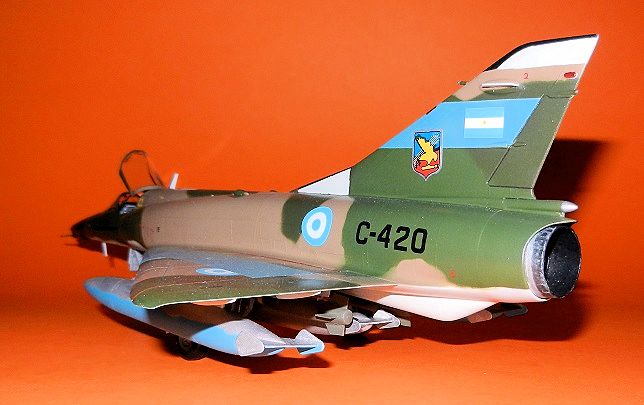 C-420 took
part in 9 combat missions and along C-418 and C-421 she was one of the Daggers
that flew the most during the conflict.
C-420 took
part in 9 combat missions and along C-418 and C-421 she was one of the Daggers
that flew the most during the conflict.
All the pilots that flew C-420 were not shot down and survived the war.
On June 25th the II Escuadron Aeromovil returned to Tandil. They had
dropped 84 bombs and fired 2,920 x 30 mm rounds.
In 1983 C-420 was modified to the Finger II configuration (similar to the Kfir
standard) followed by IIIA in 1985 and IIIB in 1987/88. The plane was still in
service in 2012…
| THE KIT |

It has 2
types of drop tanks, some bombs, 3 types of missiles (including the Matra 550
used by the Argentine Air Force during the war in their MIIIs) and decals for
several versions: Australian, Spanish, French, Swiss. Two exhaust types (C and E
version) are supplied. So there are plenty of versions to be built with this
kit.
This kit has been reissued a few years ago and competes with low cost against the Eduard kit.
| CONSTRUCTION |
The steps
that I took are as follows:
The
nose is a resin one that replaces the Mirage III so the original one was cut
off. I needed some putty to improve the union of the resin and forward fuselage.
The cockpit was painted in dark gray, used the decals supplied by the kit for
the instrument panels (3). I added some weight around and forward of the cockpit
to prevent the plane from becoming a
tail sitter and closed the fuselage halves. There are some
 little
antennas with an “oval” base on the tail. I cut these shapes from plastic and
used Putty to improve the union.
little
antennas with an “oval” base on the tail. I cut these shapes from plastic and
used Putty to improve the union.
To improve
the union of the wings-fuselage, I cut some pieces of plastic spruce and placed
them below the top root of the wings. The top of the wings was glued next and
lots of care and putty was needed to eliminate the trench left in the underside
of the border of attack. I had, anyway, to re-scribe some of the round
inspection panels. White acrylic base was used to fill the gap between the top
of the wing roots and the wings.
Main landing
gear was attached next. As the planes flew with 3 drop tanks and the kit brings
2, I copied an extra one and its station using resin and a cast made of rubber.
It was a 2 part resin (Araldite) that once set required lots of glue and putty
to improve the union of the 2 pieces I made.
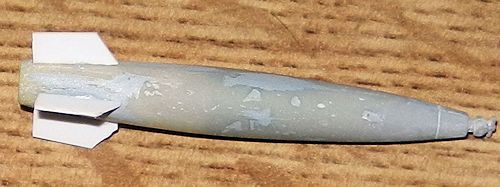 The
bombs are from the Hobby Craft A4 Skyhawks kit, but I modified the tail (using a
previously scratchbuilt and casted rubber mold) to represent the version with
parachute to slow down them and give time for the bomb to get armed. The fins
were made using Evergreen as were the 2
VHF antennas and the two on the tail.
The
bombs are from the Hobby Craft A4 Skyhawks kit, but I modified the tail (using a
previously scratchbuilt and casted rubber mold) to represent the version with
parachute to slow down them and give time for the bomb to get armed. The fins
were made using Evergreen as were the 2
VHF antennas and the two on the tail.
| COLORS & MARKINGS |
I used
ModelMaster Acrylic paints. First I used Light grey (4766) for all the
undersurfaces, followed by Tan (4709), then Medium Green (4734) and finally Dark
Green (4726). The lines between colours are smooth so I used Blue Tac to obtain
the desired effect.
The
yellow (4683) ID bands were painted on wings and tail. A mix of blue, white and
yellow was created to faithfully recreate the colour of the paint that was
obtained in the wee hours by Posada’s men. I have left
 some areas
with a lighter coat of this Turquoise colour and some of the yellow shows thru.
These ID bands also were carried under the wings and thus part of the main
landing gear doors were painted accordingly.
some areas
with a lighter coat of this Turquoise colour and some of the yellow shows thru.
These ID bands also were carried under the wings and thus part of the main
landing gear doors were painted accordingly.
Tip of
the bombs was painted in yellow and then in Olive drab. For the nose and several
details like edge of tail I used flat black.
As the Air
Force was running short of drop tanks, some of the ones used were not painted at
all. So I chose to paint them in aluminum (top) and turquoise (below). T
Future gave
a gloss surface for the decals: a mix of Italieri (some stencils), Condor Decals
(badge on the tail with a very carefully brush painted silver edge) and
AeroCalcas. The air intakes and legs were added.
Whoops!
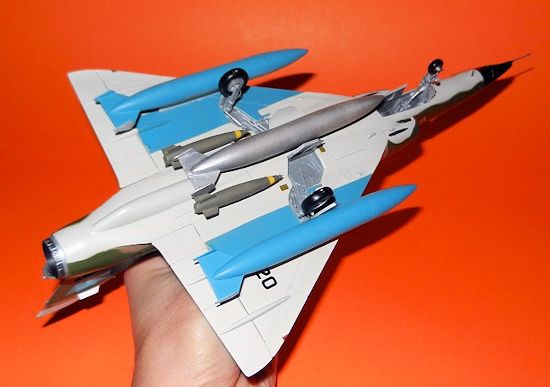 It
was at the point of having most of the decals glued that I realized I had made
two mistakes:
It
was at the point of having most of the decals glued that I realized I had made
two mistakes:
1)
Forgotten to
paint the ID bands under the wings
2)
Painted the
brown paint on the rear right side of the fuselage too much towards the exhaust
pipe.
I needed to
take some action:
1)
Very
carefully and with a cloth soaked in window cleaner I removed part of the Future
under the wings trying to eliminate it from the area that I had to paint…as we
know that Future and water based paints on top of it don’t work very well! I
managed to pull some paint off as well…but at the end I was able to give it a
successful coat of yellow and then turquoise (that I had saved in a little
bottle) after masking the rest of the undersides.
2)
Again,
window cleaner to the rescue. I removed a large part of the Future in the rear
right fuselage area, masked the area to give it the correction of the 3 main
fuselage colours until the area was now properly represented. Then more Future
and a new set of numbers was applied as the original one was destroyed when
eliminating the Future.
Finally, a
coat of semi-gloss clear varnish from AeroMaster to seal the decals.
| FINAL CONSTRUCTION |
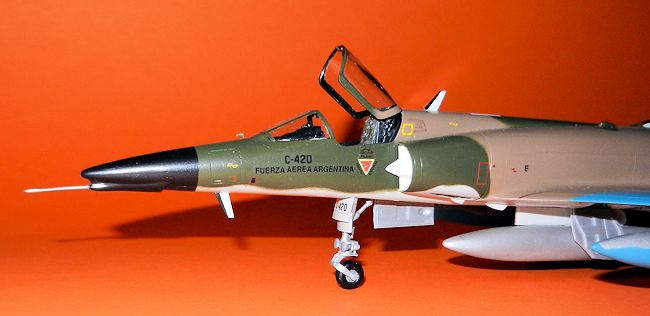 The
last details were the pitot tube on the nose (modifying the Esci one for MIII),
the one in front of the windshield, the gunsight, the supports for the air
intakes (scratchbuilt), 2 VHF antennas (scratch), 2 antennas on the tail
(scratch).
The
last details were the pitot tube on the nose (modifying the Esci one for MIII),
the one in front of the windshield, the gunsight, the supports for the air
intakes (scratchbuilt), 2 VHF antennas (scratch), 2 antennas on the tail
(scratch).
The
entire plane was given a coat of satin varnish.
And finally the last details were added: Pavla seat, rear mirrors and handles for the canopy, position lights painted, bombs, external drop tanks, nose landing gear lights, wheels and doors for the wheels wells.
| CONCLUSIONS |
Another Dagger for my collection made using the Italeri/Esci old kit. It is
certainly showing its years. In this case the kit represents one of the most
famous ID band configurations flown by those brave pilots who had to learn the
air to sea warfare basics on the go and put it to good effect even though they
were many times let down by the bombs failing to explode due to the ultra-low
height and fast feed that were the only tools they had to guarantee more chances
of a safe return to their base. Hats off to them!
Thanks to:
EC, Guillermo Posadas
| REFERENCES |
·
Halcones de
Malvinas (Pablo Carballo)
·
Historia
Oficial de la Fuerza Aerea, Volumen 6 (Malvinas), Book 1 and 2
·
Ellos
tambien combatieron (Guillermo Posadas) – in charge of Maintenance of the II
Escuadron Aeromovil during the war
·
Guerra Aerea
en las Malvinas (Benigno Andrada)
·
Dagger &
Finger en Argentina (Horacio Claria et al.)
·
Four weeks
in May – Capt. Hart-Dyke
·
Falklands
Air War - Hobson
·
IAI Finger
1978-1982 - Nunez Padin
· Defensa Sur
February 2015
If you would like your product reviewed fairly and fairly quickly, please contact the editor or see other details in the Note to Contributors.